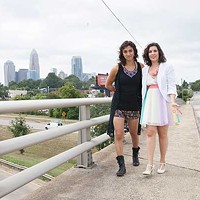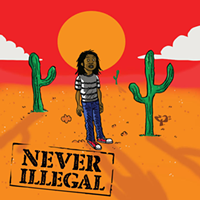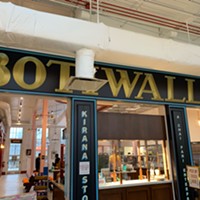Aroma therapy: The Birth of Coffee
Exhibit sheds light on popular beverage
By Joanne Spataro @lookitsjoanneOn a cool morning in the small Ethiopian town of Yirgacheffe, a farmer wrapped in a white cloth stands outside his thatched-roof hut. There's no cup of coffee in his hands to jolt him awake, but he is surrounded by the fragrant plants that produce the berries which bear the "beans" from which we brew our coffee every morning.
The man is a subsistence farmer. For him, coffee isn't just a drink; it's his way of life.
You can see this and other scenes in The Birth of Coffee, a traveling exhibit that premiered at Discovery Place earlier this month. The display has its origins in a book published by Random House in 2000: Journalist and photographer Daniel Lorenzetti had taken photos of lush coffee fields while writer Linda Rice Lorenzetti wrote the text for the visuals. In 2002, the couple embarked on an international tour, showcasing their photos, words and artifacts. The official exhibition began two years later in cities including Bologna, Italy; Sydney, Australia and São Paulo, Brazil. The goal was to show people where their daily mocha latte frappuccino really comes from.
But why is such an adult topic showing at a museum usually reserved for kids shows?
"We do want to bring in things from time to time that are appropriate for adults or that adults enjoy seeing, too," says Logan Stewart, a spokesperson for Discovery Place. "This is a good example of something that adults will enjoy."
All coffee from around the world can trace its roots back to the ancient coffee forests of the Ethiopian plateau. In countries where coffee is cultivated by hand, the process is the same today as it was in ancient times. Coffee trees produce a deep red fruit called a coffee cherry. Farmers pick the cherries, which are then processed until the seeds inside — what we call beans — are ready for export. It's a complex, laborious process that few casual coffee drinkers understand.
"[Coffee, chocolate and vanilla] are similar in the sense that when you pick them off the plant, they don't smell anything like the product we love," says Paula Gross, assistant director of the Botanical Gardens at University of North Carolina Charlotte and a lecturer in biology. "They have to go through this process of natural fermentation, where the product is enzymatically changed by micro-organisms and the humidity promotes that so the characteristic flavor we experience isn't present right there in the whole tree. It's in the processing that it comes out."
The Arabian Peninsula became the first to cultivate and trade coffee, and by the 16th century, the brew was well-known in Persia, Egypt, Syria and Turkey. For Muslims whose religion forbid drinking alcohol, coffee became a delicious, caffeinated substitute. Men would go to public coffeehouses, called qahveh khaneh, in cities across the Near East. When Europeans began visiting the Middle East, they had mixed reactions to coffee — some called it "the bitter invention of Satan" until Pope Clement VII sampled the beverage and gave his holy stamp of approval to it around 1600. Coffee's popularity then spread around the world.
Today, coffee is the biggest food import and second most valuable commodity in the United States. This country spends about $4 billion a year importing coffee from countries including Brazil (the largest importer and exporter overall, per Global Exchange statistics), Colombia, Guatemala, Mexico and Vietnam, among others. But while Americans love their java, most of us are disconnected from its journey from field to cup.
"Somebody's hands are harvesting this coffee," says Gross. "When you think about that, you think about, what if you were the coffee farmer?"
Through its photos and other media, The Birth of Coffee introduces us to coffee farmers from Indonesia, Yemen and Costa Rica, capturing each of them in personal moments. One photo shows a man from the village of Sulawesi, Indonesia, proudly sitting by a small basket of his harvested coffee beans. It's not the amount, but the quality he seems to appreciate, a feeling of pride that even a barista at a locally owned coffee shop could relate to.
"It's really neat to see all the different varieties and all the different colors of beans," says Sasha Elliott, manager of Charlotte coffee shop Jackson's Java, which roasts its coffee beans on-site. "We have character in our coffee."
(The exhibit The Birth of Coffee will be on display through Jan. 7, 2013, at Discovery Place, 301 N. Tryon St. For more information, call 704-372-6261 or go to www.discoveryplace.org.)
Speaking of...
Latest in Food & Drink Features
More by Joanne Spataro
-

Everybody Needs Somebody, Even the Nacho Slobs
Feb 8, 2017 -

Batman gets spanked at Purgatory
May 27, 2015 -

His name was Blake
Mar 25, 2015 - More »
Calendar
-

Haw River Wine Tasting @ Carolina Beer Temple.
-

Haw River Wine Tasting @ Carolina Beer Temple.
- Wed., April 24, 5-7 p.m.
-

TRIVIA THURSDAYS!!! @ Elizabeth Parlour Room
-

LIVE MUSIC FRIDAYS: TRACE CASANOVA @ Elizabeth Parlour Room at Hooligans FC
-

Charlotte Grilled Cheese Festival @ SouthEnd Station.
-
How to build a brewery 1
It's not for the Mild
-
Dorie Greenspan's Tiramisu Cake
This layered cake is definitely a "pick-me-up" with a little booze and caffeine.
-
Of Comfort Food, Cheese and Chefs
Looking back at cuisine trends in Charlotte















